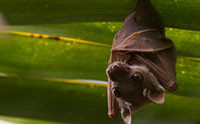The way in which a cow turns sunshine, water and grass into milk defies evolutionary explanations. …read more Read more here: creation.com
In 1994 the prestigious journal Science shocked the scientific world by publishing sequence data from DNA retrieved from dinosaur bone said to be 80 million years old. DNA is a fragile molecule, and so it breaks down quickly. Measurements of DNA stability suggest it could last thousands of years, at best, under the likely conditions. But 80 million years was just too incredible for other skeptical scientists. Eventually, these skeptics were vindicated—as it became apparent that the original researchers had sequenced contaminating human DNA, not dinosaur DNA. However, in 2012 a different group of researchers published new results supporting the [More]
Did you know that animals have genetic switches? These are regulatory regions of DNA that control the genes. Scientists have noticed that dramatic things can happen when a genetic switch is mutated. For instance, a mutated genetic switch can dramatically alter the appearance of stickleback fish, or generate a great variety of coat colours in animals. Veterinary researcher Dr Jean Lightner has suggested that God may have created genetic switches to facilitate variation, the switches having been created with a propensity to mutate without negatively affecting other traits. Modifications to genetic switches are not examples of ‘evolution in action’, even [More]
What does a cow have in common with a compass needle? The answer is that both of them ‘know’ the orientation of the earth’s magnetic field. No, this isn’t crackpot science. In 2008, the prestigious journal, the Proceedings of the National Academy of Sciences USA, published research documenting how cows grazing in a field have a tendency to align themselves with the earth’s magnetic field. And this phenomenon isn’t just limited to cows; many animals including deer, birds, turtles, bats, and even some bacteria, can sense the earth’s magnetic field for alignment or navigation. The fact that so many living [More]
We are commonly told that similarities between living things prove that they are related by evolution, but did you know that many similarities found in nature defy evolution? Take for example the marsupial mouse and the placental mouse. These creatures are remarkably similar, but according to evolutionists they did not inherit this startling similarity from a common ancestor. Instead, we are told, ‘evolution’ achieved the same design in both creatures, independently. They call this ‘convergence’ because evolution has supposedly converged on, or arrived at, a similar looking outcome. But ‘convergence’ is really just a word used to try to explain [More]
Camels can tolerate up to 30% loss of bodyweight by dehydration-twice that which would kill most other mammals. …read more Read more here: creation.com
The creation of original, distinct creature kinds confronts the evolutionary teaching that animals can endlessly morph from one form to another. Recent news reports reveal two clear illustrations of sea creatures living and reproducing according to their kind right from the start. More… …read more Read more here: icr.org
Bodies bounce while jogging or performing any number of other vigorous activities, usually without getting dizzy. However, bodies get dizzy when they are “bounced” from the outside, like while on a boat or airplane. What’s the difference? Researchers pinpointed amazing new details behind the mechanism that maintains balance during voluntary motion, but their notion of its origins clearly misses the mark. More… …read more Read more here: icr.org
By Dr. Nathaniel T. Jeanson New data agree with the expectations from D-loop results, further confirming the origin of humans within 6000 years and rejecting evolutionary timescales. …read more Read more here: AIG Daily
By Dr. Elizabeth Mitchell The ocelloid—a camera-like “eye” inside single-celled marine plankton—is an amazing design, but it does not represent an evolutionary triumph. …read more Read more here: AIG Daily
By Ken Ham Shoulder blade shapes have been compared between humans and existing apes as well as fossilized apes. Well, evolutionists wouldn’t call the fossils apes. An article stated that a recent study suggests that the last common ancestor (often shortened to LCA) of humans and apes “looked a lot like a chimpanzee or gorilla . . . at least in the shoulder.” The PNAS study, titled “Fossil hominin shoulders support an African ape-like last common ancestor of humans and chimpanzees,” explains, A laterally facing shoulder blade allows humans to store energy in their shoulders, much like a slingshot, facilitating [More]
By Dr. Elizabeth Mitchell Zhenyuanlong is not a blow to biblical belief or proof that dinosaurs evolved into birds, but a testimony to avian diversity of the pre-Flood world. …read more Read more here: AIG Daily
By Ken Ham A recent article in the Sunday Times claims that “of all the scientific fields, evolution probably carries the most common misconceptions.” It then goes on to describe 10 alleged misconceptions of evolutionary ideas. Many of these misconceptions are topics we’ve already pointed out and covered on our website. As Christians we need to be careful not to misrepresent what evolutionists believe, so we encourage Christians to avoid certain arguments. But some of the alleged misconceptions about evolution that made the Sunday Times list are actually not misconceptions at all! The article begins with a common argument that [More]
Engineers look to copy the hummingbird’s aerodynamic secrets in their designs for miniature flying robots …read more Read more here: creation.com
Even children learn that plants and animals depend on one another. Plants release oxygen for animals to breathe, and plants make food—mostly sugar—for animals to eat. In turn, animals produce carbon dioxide so plants can grow using sunlight. This ecological interdependence shows enough divine design to inspire any honest thinker to consider a Creator, but a recently discovered interaction between pitcher plants and bats shows even more. More… …read more Read more here: icr.org
Despite what evolutionists say, mutations are not evidence for evolution but rather evidence against it. …read more Read more here: creation.com
By Dr. Nathaniel T. Jeanson Some assert that humans and chimpanzees are only 1 to 2% different, but careful re-tallying suggests there is a gigantic genetic gap between the two species. …read more Read more here: AIG Daily
How studying the influenza virus gives clues about natural selection. …read more Read more here: creation.com
A BBC News story reported on September 10 the discovery of a “new human-like species” in Africa, stating “researchers claim that the discovery will change ideas about our human ancestors.” As always, we at the Institute for Creation Research are extremely skeptical, taking such breaking news stories with a little more than a grain of salt. We have found that with more time and research, the preliminary spectacular claims of alleged “human ancestors” dissolve into a footnote, a non-story. More… …read more Read more here: icr.org
Observed mutational decay in the human genome provides clues to the origin of life. …read more Read more here: creation.com
Microscopic ‘water bears’ are a puzzle for evolutionists. …read more Read more here: creation.com
Are some dino ‘evolutionary series’ actually just different growth stages of the same type of dinosaur? …read more Read more here: creation.com
By Dr. Elizabeth Mitchell Human hands differ markedly from those of long-fingered monkeys and arboreal apes like chimpanzees and orangutans. Did one evolve first? …read more Read more here: AIG Daily
Long before Darwin, William Paley outlined the evidence for Divine design in living things, the natural world and the universe. …read more Read more here: creation.com
By Ken Ham Horse-lovers (and there are lots of them here in Kentucky!) might be interested in new research from the University of Sussex on horse facial expression. Apparently, according to this new research, “horses use a wide range of facial expressions as social cues—much like humans do.” Horses reportedly have seventeen “discrete movements, many of which are also used by humans, despite obvious differences in facial structure.” Humans, however, have twenty-seven “action units,” or facial movements, as opposed to the horses’ seventeen action units. Reportedly “both horses and humans modify their facial expressions roughly the same way—by using facial [More]
A new study published in The Open Evolution Journal described a paradox that particles-to-people evolution has failed to resolve. Called the “mutation protection paradox,” it could be an intractable problem that would leave creation as the only viable origins hypothesis. Study researchers observed that both living organisms and computer programs that copy and transmit coded information have built-in error detection and error correction systems. These systems are required to maintain the information’s integrity, which would otherwise be eroded by constantly accumulating random mutations. The coded information, organized in small sets called “bytes” in binary computer code and “codons” in the [More]
As weird as it may sound, some snakes had legs. Fossils reveal little legs on ancient snakes that have apparently been extinct for some time. Yet, those had only hind legs. Now, in the journal Science researchers describe a new fossil with four limbs. They suggest that this new fossil illustrates how legged snakes evolved from legged lizards. Is this accurate? More… …read more Read more here: icr.org













































